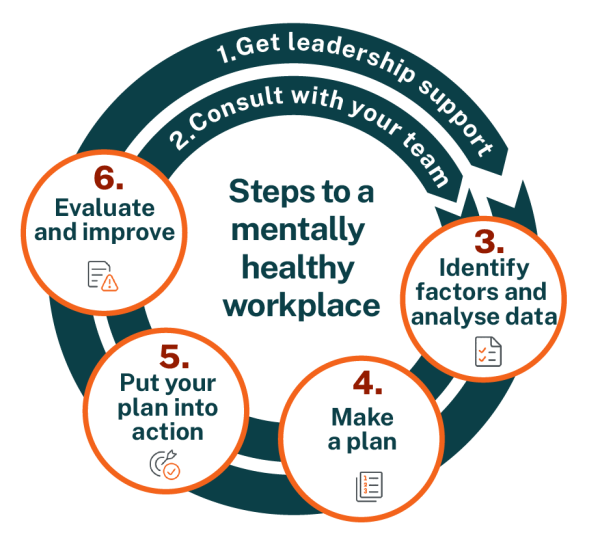How to create a mentally healthy workplace
Knowing where to start, or what to do next, can sometimes seem unclear. Use this practical, step-by-step advice to create a mentally healthy workplace.

Step-by-step guide to creating a mentally healthy workplace
The task of building a mentally healthy workplace can seem daunting at first, but this page will take you through all six evidence informed steps. Keep in mind it's important to maintain support from leadership and consultation with your team as you progress through this continuous process.

Image

Step 1 – Get leadership support
Taking action for good mental health starts at the top.
Get the support of your leadership or executive team so they can help drive positive change in your organisation.
Leadership sets the tone, culture and policies across a business, so genuine engagement from the top will drive positive change.
Get the support of your leadership by:
- finding out how your business is tracking in being mentally healthy with our Workplace Pulse Check. Your results will show how you compare with your industry. Share your results with your leadership team and discuss what actions can be taken to improve
- talking to your leaders about why mental health is important to your team and the benefits a mentally healthy workplace can have on the business’ bottom line. WorkSafe's return on investment calculator can help you show how much money you could save.
- asking your leadership to share their commitment to creating a mentally healthy workplace with the whole organisation
- it's important for leaders to empower everyone in the workplace with adequate resources and ensure everyone understands their legal obligations
- sharing with your leadership the benefits of being a mentally healthy workplace and how it impacts their staff, business reputation, productivity and bottom line.
Image

Step 2 – Consult with your team
Ask your team what changes would better support their health and wellbeing.
Your workers know best what they need to do their jobs effectively. Talk to them.
It is important to consult with your team throughout the whole process about what workplace factors are affecting them and how you can provide a working environment that supports their mental health and wellbeing at work.
You can do this through:
- staff surveys, focus groups, workshops or one on one conversations
- regular check-ins on improvements or adjustments for continual improvement
- genuine communication with your team regularly and transparently
- finding your mental health champions - start up a team of people in your workplace who are passionate about creating a mentally healthy workplace and discuss opportunities to make a difference.
Image

Step 3 – Identify factors and analyse data
Often the information needed to understand and identify factors impacting mental health in your workplace already exists or can easily be obtained.
Take this approach:
- continue the consultation process to understand your team's perspective
- analyse your human resources data such as unplanned leave, workers compensation claims, access to support services and tools, and reports of bullying and harassment
- take the Workplace Pulse Check to get a confidential assessment of how mentally healthy your workplace is in five minutes
- for a more detailed assessment, survey your staff using the Workplace Wellbeing Assessment. You'll learn how well your organisation is managing areas important to workplace mental health, like leadership and culture. You'll also get a tailored report with recommended actions to improve your workplace, based on your results
- the People at Work tool can also help you identify and manage your level of risk for common psychological factors, like bullying and harassment.
You also need to consider:
- the unique factors that the nature of your workplace and the type of work carried out creates
- the cumulative effect of work demands on your employees over time.
This data and feedback will help you understand what areas need to be addressed as you form your action plan.
Image

Step 4 - Make a plan
The next step is to take the information you’ve gathered and put it into an action plan.
Having your plan documented will help ensure you stay on track, allowing risks to be mitigated and mental ill-health supported.
Your plan should contain specific and achievable initiatives and actions that can be measured and monitored.
Remember to consider the factors that you identified in step 3 and outline actions to manage each one.
Your action plan should focus on these three areas:
Promoting mental health and wellbeing in the workplace can help create a supportive and inclusive culture while also reducing stigma and opening up communication.
Meaningful promotion of mental health must start at the top. Ensure all levels of leadership commit to building and supporting a mentally healthy workplace for all.
See a list of specific actions you can take to promote good health in your workplace.
A mentally safe workplace is designed in the same way as a physically safe workplace. By creating a workplace with a safety-first culture, the known risks to mental health can be reduced or mitigated.
See how you can incorporate mental health risk management actions into your plan.
Nearly 1 in 6 workers are experiencing poor mental health at any given time. This means mental ill-health is likely to be in your workplace.
Many people may not notice the changes within themselves or be aware they need help. Encouraging your workers to seek help early can reduce the impact and severity of poor mental health. Proactively providing this support may also assist people to recover more quickly, and help your business reduce staff turnover.
Make sure your plan includes practical actions to support early help-seeking and good recovery.
To get your plan started, see our list of top practical actions and initiatives you can roll out now.
Workplace Wellbeing Assessment
Survey your workers and get tailored actions to improve your workplace. Our free digital tool allows you to:
- consult with your team
- identify factors and analyse data; and
- make a plan.
That's steps 2, 3 and 4 to creating a mentally healthy workplace with one tool!

Image

Step 5 – Put your plan into action
Your plan needs to be put into action, not just sit on a shelf.
Your plan and policies will work best when they’re clearly and effectively communicated to everyone in your workplace.
Be sure to include it in induction training and make sure it’s easily accessible in hard and soft copy. This helps you continue the consultation throughout the process.
Below, watch South Western Sydney Primary Health Network’s journey creating their workplace mental health wellbeing plan and putting it into action, with positive results for both staff and the business bottom line.

Creating a mentally healthy workplace – South Western Sydney Primary Health Network
Image

Step 6 – Evaluate and improve
The journey to a mentally healthy workplace is a process of continuous learning, consultation, feedback and improvement.
Make sure you:
- keep a record of all the workplace factors identified and the actions taken to address them
- check-in with your team all the time – are things improving? Has there been a positive change in culture? What more can be done?
- look at your business data – are you seeing a reduction in unplanned leave or increased productivity?
- continually monitor progress and make adjustments if needed.
The National Mental Health Commission has more information on how to use data that's already in your business to track the progress and outcomes of your plan.
Next steps
Image

Find out how mentally healthy your business is with the Workplace Wellbeing Assessment
Survey your workers and get tailored actions to improve your workplace with our free digital tool.
Image

Sign up for free training and coaching
Join our mailing list
Be the first to hear new announcements, free training, recently published resources and more.